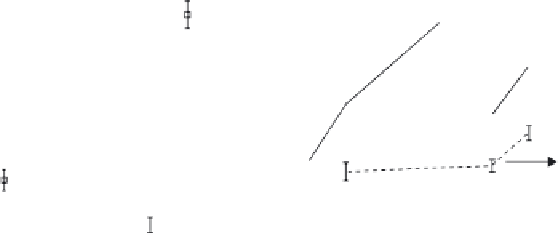Biomedical Engineering Reference
In-Depth Information
1600
400
6
Eucalyptus
(a)
(b)
1400
Axial
Radial
5
Eucalyptus
1200
300
Maple
4
1000
800
200
3
Beech
600
2
Maho.
400
100
Beech
1
200
Beech
Beech
0
0
0
0
2.1
2.2
2.3 2.4
2.5
2.6
2.7
0
2.1
2.2
2.3 2.4
2.5
2.6
2.7
Density (g/cm
3
)
Density (g/cm
3
)
Figure 11.12.
Ambient temperature mechanical properties of the biomorphic Si/SiC com-
posites: (a) compressive strength; (b) fl exure strength measured in four-point (solid lines and
symbols) and fracture toughness (open circles and broken line).
2002 ; Presas, 2005 ; Presas, 2006 ; Kaul, 2006 ; Smirnov, 2003 ; Kardashev, 2005 ;
Kardashev, 2006; Gutierrez-Mora, 2005]. This section presents the results more
directly related to the use of this material as medical implant.
The mechanical properties of the biomorphic composites at ambient tem-
perature are plotted as a function of density in Figure 11.12. [Presas, 2005]. The
axial compressive strength (Figure 11.12a) of the Si/SiC composites was a linear
function of the density, and this is in agreement with previous results on the com-
pressive strength of biomorphic Si/SiC manufactured from pyrolyzed poplar and
obeche [Singh, 2002], in which the porosity was also the main factor controlling
the strength. Of course, the particular microstructure of the biomorphic compos-
ites, inherited from the precursor woods, was responsible for the anisotropy in
the compressive strength along the axial and radial directions in beech (Figure
11.12a), and thus the oriented microstructure of the biomorphic composites
provide optimized properties when loaded along the trunk axis. But the results
indicate that the main factor controlling the axial compressive strength was the
biomorphic density (or, inversely, porosity) rather than the actual precursor
wood.
The behavior in bending and fracture is plotted in Figure 11.12b and shows
that the strength and toughness of the beech-based biomorphic composite with
low density (2.1 g/cm
3
) was similar to that of the beech- and eucalyptus-based
materials with higher density (2.5 - 2.6 g/cm
3
). The fl exure strength measured in
four-point bending by Singh and Salem [Singh, 2002] on mahogany and maple-
based biomorphic Si/SiC composites processed by the same technique is also
included in Figure 11.12b. Maple and mahogany are also hardwoods and their C
templates also present the typical bimodal pore structure. However, no free C was
found in these biomorphic composites and their fl exure strength was in good
agreement with results in C-free low-density biomorphic Si/SiC composites



















Search WWH ::

Custom Search